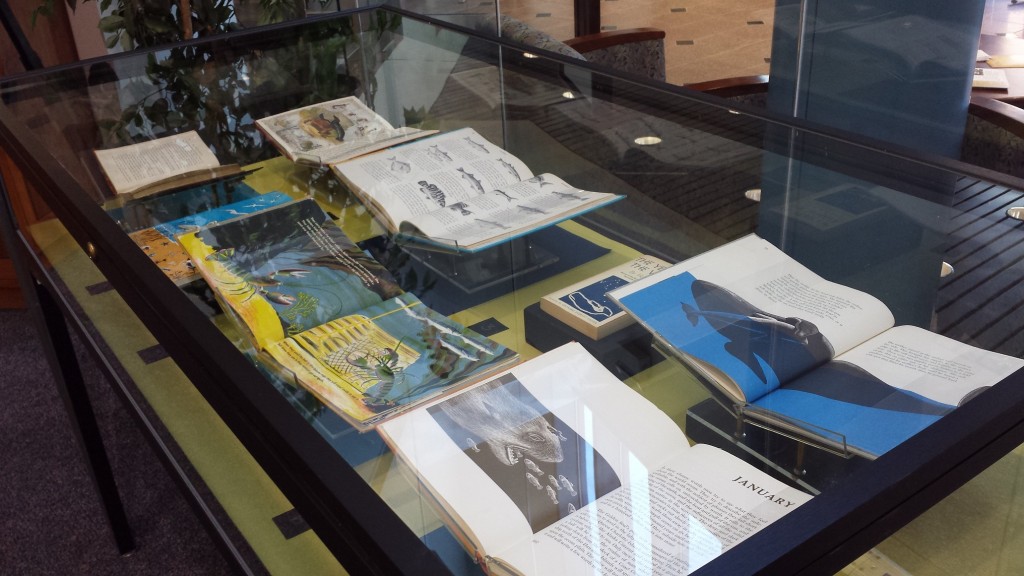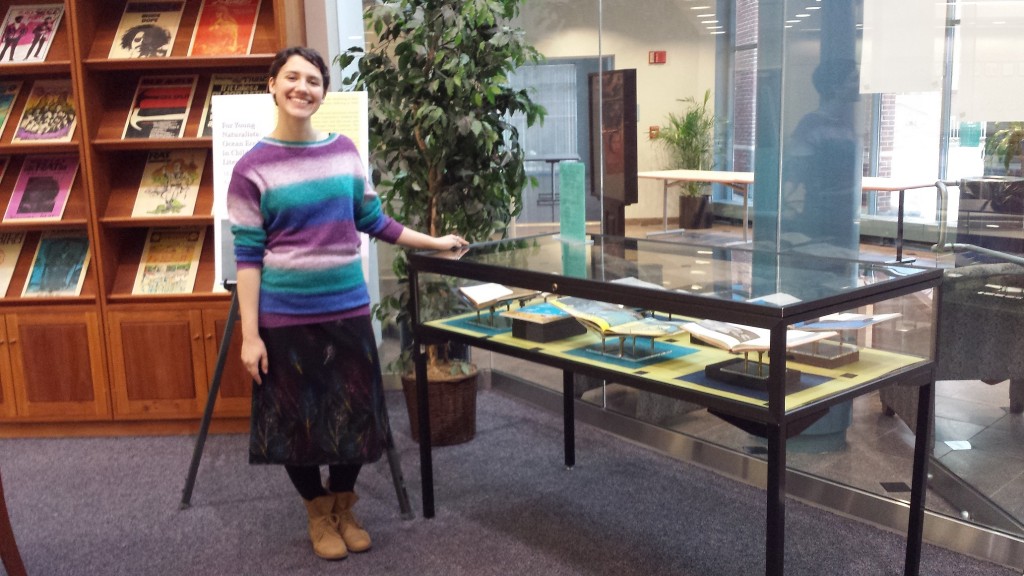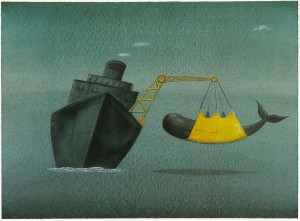 The idea to create “For Young Naturalists” was a product of two major influences: my desire to curate an exhibition (which I’ve always wanted to do) and my desire to explore the NCLC Collections. I’ve always been aware that Archives and Special Collections is home to over 40,000 children’s books and serials, but until this semester I had never viewed any of them.
The idea to create “For Young Naturalists” was a product of two major influences: my desire to curate an exhibition (which I’ve always wanted to do) and my desire to explore the NCLC Collections. I’ve always been aware that Archives and Special Collections is home to over 40,000 children’s books and serials, but until this semester I had never viewed any of them.
Though I originally intended to focus on ocean ecology in children’s literature as a way to complement themes covered in the final two Edwin Way Teale Lectures of the semester, my exhibit quickly took on a new interpretive life. Children’s books are powerful tools for teaching children and young adults age-appropriate information about a variety of topics. As I browsed the books, I tried to determine how each book conveyed information, simply entertained, or communicated a broader message to their readers. I then considered artistic choices made by the authors and illustrators, and how relationships between humans and the ocean, and amongst ocean creatures, were depicted.
I discovered that the ethic of each book reflects the beliefs and attitudes of the time period in which they were produced. The earliest examples from the nineteenth century, including The Ocean and its Inhabitants: With their Uses to Man (1844), describe the process of extracting oil from whale blubber, and the common usage of this oil. This provided a stark contrast to later examples, such as Whales Way (1972), which anthropomorphizes humpbacks and vilifies the humans who hunt them.
I also discovered that time affects content in another way: as our knowledge of ecological relationships becomes more complex, so do our stories. In My Grandpa and the Sea (1990) the main character’s grandfather begins to farm sea moss as his traditional fishing methods can no longer compete with more efficient technology. Ocean Sunlight: How Tiny Plants Feed the Sea (2012) describes, in simplified terms, why phytoplankton are crucial to all ocean life.
“For Young Naturalists,” on display through this Thursday, includes children’s books  and associated artwork from the late 19th century through the present, though the majority of the materials included date from the late 1960s – to the early 1990s. Three of my favorite items in the exhibit are outlined below.
and associated artwork from the late 19th century through the present, though the majority of the materials included date from the late 1960s – to the early 1990s. Three of my favorite items in the exhibit are outlined below.
Along the Seashore, Written & Illustrated by Margaret Waring Buck (1964)
Margaret Waring Buck dedicated Along the Seashore (1964) to “beginner naturalists;” I chose to use a modified version of this descriptor as the title for this exhibition. Along the Seashore is only one of several examples of Margaret Waring Buck’s work in Archives & Special Collections. As an author and illustrator who lived along the Connecticut shoreline, Buck focused primarily on illustrating books about nature for children. Her papers, which include original artwork for her other nature-themed books also include sketchbooks filled with nature drawings based on observation. Along the Seashore is a unique encyclopedia for seashore discovery. Covering plants to water birds, it provides children with the common names and basic facts about species they might find along the seashore, complimented by realistic sketches. I love the neatness of Buck’s artwork and the dignity she confers on her juvenile readers by entrusting them with complex knowledge about ocean creatures.
The Year of the Seal by Victor B Scheffer, Illustrated by Leonard Everett Fischer (1970)
This book, intended for young adult and adult readers, but appropriate for younger audiences, follows the development of a baby Alaskan fur seal during the first year of its life. The book is similar to another written by Victor B. Scheffer, a biologist, and illustrated by Fischer, titled The Year of the Whale, which follows the development of a baby sperm whale calf during the first year of its life. Though Year of the Seal is informational, it is also poetic. Commenting on man’s attempts to describe the ocean writes, Scheffer writes in an aside, “The ocean rolls on, untouched by words. It rolls to the turning of the earth, and the heat and pull of the sun, and the drag of the moon, and the influences of all the solid and gaseous matter of the universe.” Original illustrations for both The Year of the Seal and The Year of the Whale, as well as a third book included in the exhibit (The Journey of the Gray Whales by Gladys Conklin, 1974) are housed in Fischer’s papers at Archives & Special Collections.
An Ocean World, Written & Illustrated by Peter Sis (1992)
Sparse in text, Peter Sis’s beautiful watercolor illustrations follow the journey of a whale, recently released into the ocean, in his attempt to find a friend. Though the book is less realistic, it is highly imaginative, depicting the young whale in a variety of  situations – coming face to face with a submarine, finding love with another whale – that are comical, jarring, relatable, and insightful. The image on the left, featured on the poster for the exhibit, depicts the moment when the whale is first released into the ocean. Though it depicts humans performing a “helping” act, the dark colors in the background and the inherent ambiguity of the image when viewed out of context (Is the whale being removed from the water? Or put back into it?) accurately suggest a complex relationship between man and whale.
situations – coming face to face with a submarine, finding love with another whale – that are comical, jarring, relatable, and insightful. The image on the left, featured on the poster for the exhibit, depicts the moment when the whale is first released into the ocean. Though it depicts humans performing a “helping” act, the dark colors in the background and the inherent ambiguity of the image when viewed out of context (Is the whale being removed from the water? Or put back into it?) accurately suggest a complex relationship between man and whale.
Rebecca D’Angelo is a senior undergraduate student in History and Anthropology. She is student curator of the exhibition Archives and Special Collections at the Dodd Research Center, University of Connecticut.
